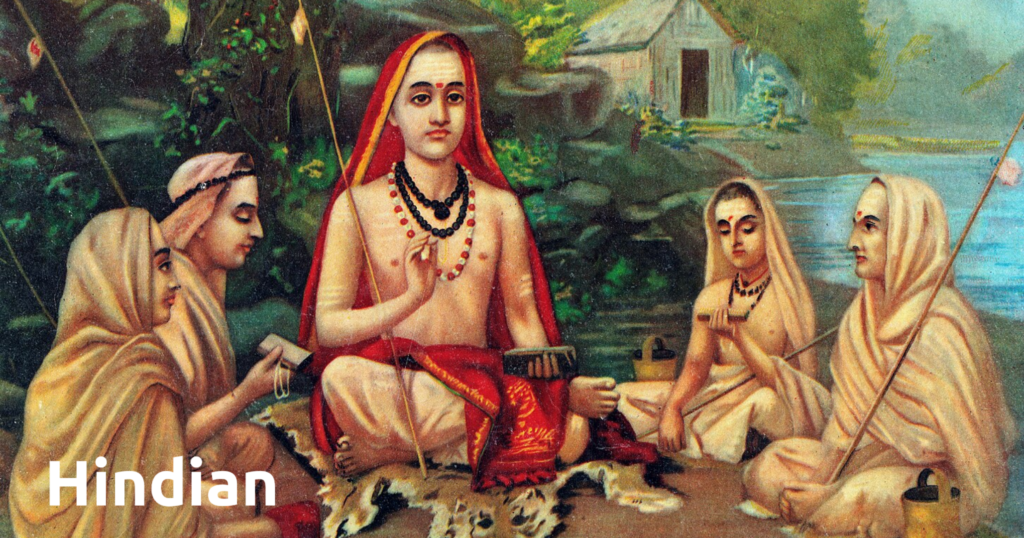In the vast history of Sanatan Dharma, few names shine as brightly as that of Jagadguru Adi Shankaracharya, the 8th-century philosopher and reformer whose influence remains deeply embedded in the spiritual, intellectual, and cultural fabric of Bharat. At a time when Hinduism was fragmented, plagued by ritualism, facing the rise of heterodox sects like Buddhism and Jainism, and suffering from internal confusion and philosophical disarray, it was Shankaracharya who reignited the flame of Vedic wisdom and reestablished the core tenets of Dharma.
This article explores how Adi Shankaracharya revived Hinduism not merely as a religion, but as a living civilization.
• The Civilizational Crisis Before Shankaracharya
By the 7th and 8th centuries CE, the Indian subcontinent was witnessing:
Doctrinal confusion: Numerous sects were promoting contradictory philosophies, many moving away from the Vedic foundation.
Rise of Buddhism and Jainism: These traditions had gained royal patronage and popular support in many regions, pushing Vedic practices to the margins.
Decline of Vedic authority: Ritualism, caste rigidity, and misinterpretations had weakened the spiritual vitality of the Vedas.
Fragmentation of Hindu thought: Schools like Nyaya, Vaisheshika, Mimamsa, and Sankhya had grown more scholastic and isolated from common spiritual practice.
Into this intellectual and spiritual chaos was born Shankara, a boy from Kalady in present-day Kerala, destined to become one of Hinduism’s greatest saviors.
• Philosophical Revival Through Advaita Vedanta
Adi Shankaracharya’s most significant contribution was the consolidation and propagation of Advaita Vedanta, the non-dualistic interpretation of the Upanishads.
Core Idea: Brahman (the absolute reality) is the only truth, the world is illusory (Maya), and the individual self (Atman) is not different from Brahman.
Impact: This philosophical clarity offered a unified metaphysical foundation for all Vedic traditions. It elevated spirituality from ritual dependence to introspective self-realization, accessible to all sincere seekers.
Scriptural Anchoring: He wrote commentaries on Prasthanatrayi – the Upanishads, Bhagavad Gita, and Brahmasutras – establishing Advaita as scripturally sound and intellectually rigorous.
By doing so, he re-centered Hinduism on its spiritual core, while leaving space for ritual, devotion, and societal roles as means rather than ends.
• Defeating Non-Vedic Schools in Intellectual Debates
One of Adi Shankaracharya’s most legendary missions was his digvijaya yatra, a spiritual conquest across Bharat, where he engaged and defeated proponents of rival philosophies through Shastrarth (philosophical debates).
He debated Buddhists, Mimamsakas, Jainas, Sankhyas, and other rival schools.
His victories were not mere intellectual triumphs; they reestablished the supremacy of Vedanta and the authority of the Vedas.
Adi Shankaracharya never used force; he relied solely on scripture, logic, and compassion, often converting his intellectual opponents into disciples (e.g., Mandana Mishra).
This philosophical reassertion was crucial in defending Hinduism from decay and distortion.
• Establishment of the Four Mathas (Monastic Centers)
To ensure the continuity of his teachings and the preservation of Sanatan Dharma, Adi Shankaracharya established four mathas (monasteries) in the four corners of India:
• NORTH – Jyotirmath (Badrinath)
Veda Assigned: Atharva Veda
Current Peethadhishwar: HH Shree Jagadguru Shankaracharya, Swami Avimukteshwaranand Saraswati
• SOUTH – Sringeri (Karnataka)
Veda Assigned: Yajur Veda
Current Peethadhishwar: HH Shree Jagadguru Shankaracharya, Bharathi Tirtha Mahaswamiji
• EAST – Puri (Odisha)
Veda Assigned: Rig Veda
Current Peethadhishwar: HH Shree Jagadguru Shankaracharya, Swami Nischalanand Saraswati
• WEST – Dwaraka (Gujarat)
Veda Assigned: Sama Veda
Current Peethadhishwar: HH Shree Jagadguru Shankaracharya, Swami Sadanand Saraswati
These institutions became bastions of Vedic learning, spiritual training, and religious organization, maintaining unity across vast geography.
• Reorganizing and Revitalizing Religious Worship
Hinduism had become ritual-heavy and inaccessible to the masses. Shankara bridged this by:
Promoting Panchayatana Puja, the worship of five deities – Shiva, Vishnu, Shakti, Ganesha, and Surya – symbolizing harmony among sects.
Emphasizing bhakti (devotion) alongside jnana (knowledge), ensuring the common man could connect with Dharma.
Reestablishing temples as spiritual centers, reinforcing their role in preserving Dharma and culture.
This religious revitalization restored public faith in the Vedic path while minimizing sectarian conflict.
• Literary Contributions and Cultural Influence
Adi Shankaracharya was a prolific writer, composing over 300 works, including:
Bhashyas (commentaries) on foundational scriptures
Prakarana granthas like Vivekachudamani, Atma Bodha, and Upadesha Sahasri
Stotras like Bhaja Govindam, Soundarya Lahari, Dakshinamurti Stotra – rich in devotional and philosophical content
His writings simplified Vedantic ideas, made them accessible, and infused Hindu consciousness with clarity, confidence, and coherence.
• Unifying Bharat Spiritually and Culturally
Adi Shankaracharya’s journey across the length and breadth of Bharat, from Kashmir to Kanyakumari, Dwarka to Puri, helped reaffirm the cultural unity of India through Dharma.
He standardized traditions, ensuring local practices aligned with the Vedas.
He gave Bharat a spiritual map, where temples, mathas, and shastras formed an interconnected dharmic ecosystem.
In essence, he laid the foundation for a pan-Indian Hindu identity, which survives and thrives even today.
• A Savior of Sanatan Dharma
Adi Shankaracharya was not merely a philosopher or a monk. He was a civilizational visionary, a spiritual reformer, and a unifier of Hindu thought and society. His genius lay in reviving Hinduism without rejecting its past, he reformed without breaking, corrected without condemning, and unified without enforcing uniformity.
At a time when Hinduism stood on the edge of dilution and disintegration, Adi Shankaracharya reawakened its soul, rekindled its fire, and reinstated its supremacy.
In today’s times, as Sanatan Dharma again faces external attacks and internal confusion, the teachings and legacy of Adi Shankaracharya remain not just relevant but indispensable.
Let us remember, uphold, and honor his mission, for it was not merely a spiritual pursuit, but a civilizational resurrection.



